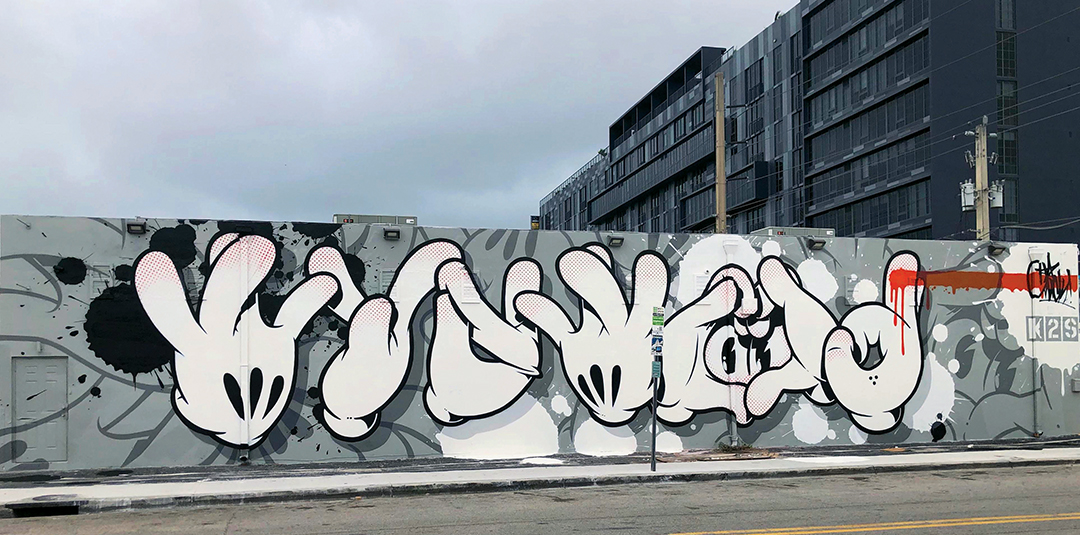
Slick, a native of Hawaii, painted this mural on the exterior of the Museum of Graffiti in Miami.
Photo courtesy Museum of Grafitti.
Its earliest practitioners were considered criminals, but now the work of some graffiti artists hangs in the nation’s most prestigious museums.
After society’s initial outrage over acts of vandalism in the name of creativity, art enthusiasts begrudgingly acknowledged that some wayward, urban painters were genuinely gifted. Over time, graffiti and street art earned a place in prestigious collections, private galleries and museums like the Museum of
Contemporary Art (MOCA) in Los Angeles and Whitney Museum of American Art in New York.
While graffiti is often viewed as an American-born genre, Michael Rooks, a curator of modern and contemporary art at Atlanta’s High Museum of Art, provides some historical context. “Graffiti and street art have their origins in the history of 20th century art — from Dada wherein text replaced image to inveigh against WWI on the streets of Zürich, to the Mexican muralist movement’s large-scale murals in post-revolution Mexico City, to Les Affichistes artists whose affiches lacérées (layers of torn posters and advertisements) were literally sourced from the streets and walls of post-WWII Paris.”
The evolution of American street art has been well documented in L.A. and New York, but the acceptance of this form of artistic expression has also occurred in Philadelphia, Miami, Chicago, and San Francisco.
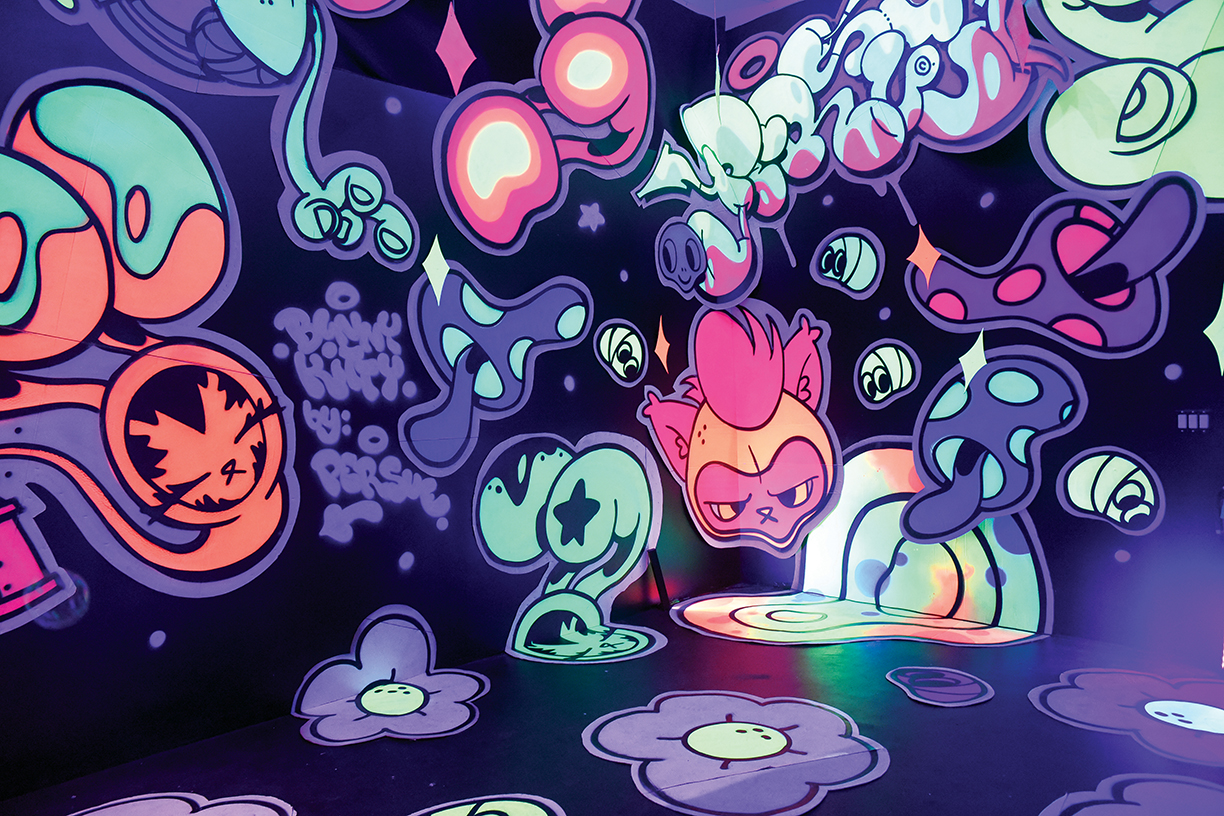
“Bunny Kitty’s Dreamstate Room” is a vibrant, playful work from artist Persue.
Photo courtesy Museum of Graffiti.
Some street artists are commissioned as muralists, a transition that monetizes and legitimizes their work, before eventually being discovered by curators. Ultimately, gallery representation leads to their art appearing in chic restaurants, hotels and private collections. Artists like Keith Haring, Jean-Michel Basquiat and Shepard Fairey — all once confined to the fringes of the art world — became creative celebrities. In L.A., the exclusive fashion boutique of Elyse Walker features artwork by RETNA, one of the most prominent local street artists, while superchef David Chang hangs the work of David Choe in Majordomo, his popular downtown restaurant. The city’s Mayfair Hotel features the work of a different street artist on every floor — resulting in diverse visual experiences for guests — and is a tribute to the depth of talent in the region.
The historic Mayfair, site of the first post-Academy Awards party in 1929, has been transformed into a trendy setting showcasing street art, curated by artist-in-residence Kelly “RISK” Graval. The Louisiana-born artist became one of L.A.’s most influential graffiti stylists and was among the pioneering artists to transition from the street to the gallery, as well as entering the worlds of fashion design and music video.
RISK’s own work is represented by a Buddha-inspired installation on the second floor and one of his murals will eventually soar above the 15th-floor pool deck. “I selected my “Metallic Tissue” series, which consists of a body of work that I paint on panels built out of repurposed spray cans,” reports RISK, who states, “They’re my imprint on society as an artist, my DNA.” He also installed some of his unique neon work in the lobby, which suits the vintage of the building. Overall, nearly 100 pieces throughout the hotel represent the diversity of L.A.-based graffiti artists and muralists like DEFER, Billy Morrison and Shepard Fairey, whose breakout work was the Barack Obama “Hope” imagery from the 2008 presidential campaign.
“There was a time when graffiti artists were a small underground subculture,” explains RISK, but adds, “The powerfully dynamic art sparked a younger generation and it exploded.” He acknowledges that street art festivals and museum exhibits helped elevate the genre within the polite corridors of the art world, but that true recognition has been stubborn.
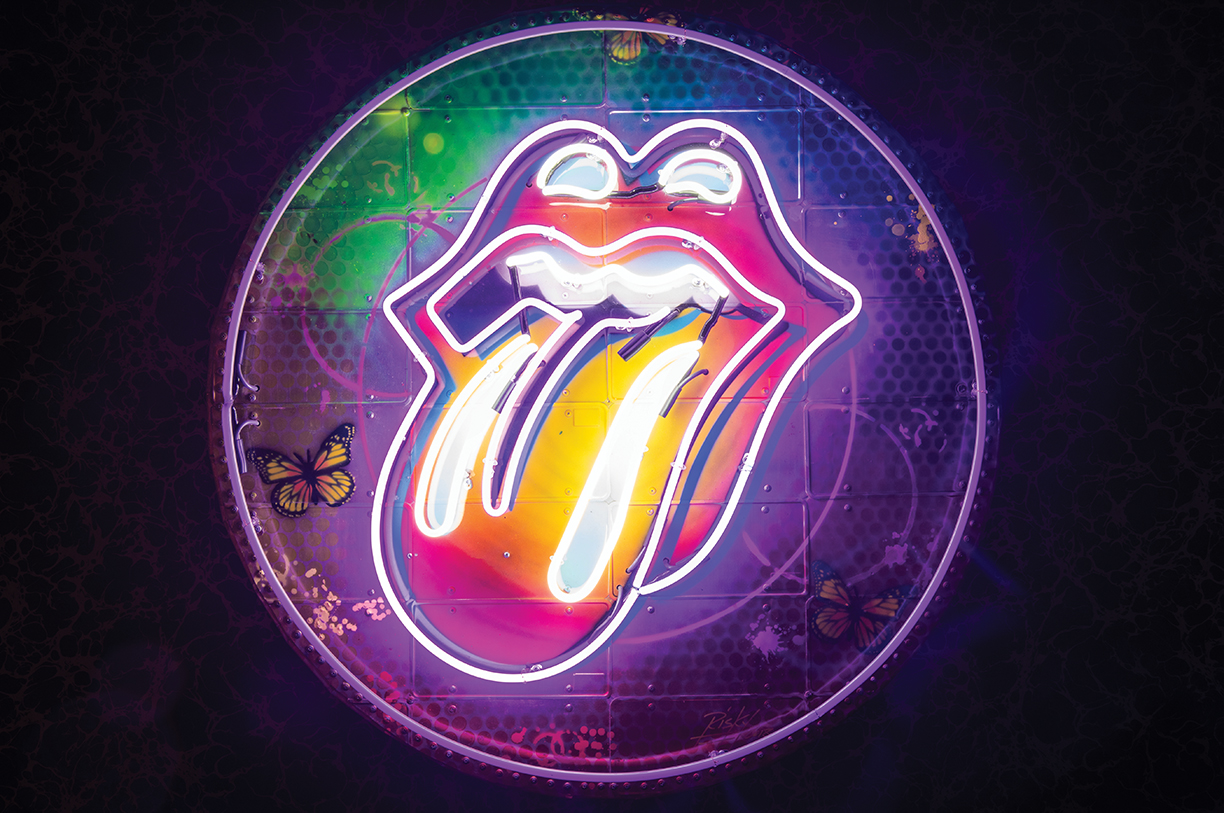
Neon work from RISK, the artist-in-residence at The Mayfair Hotel in L.A. Photo courtesy the Mayfair Hotel.
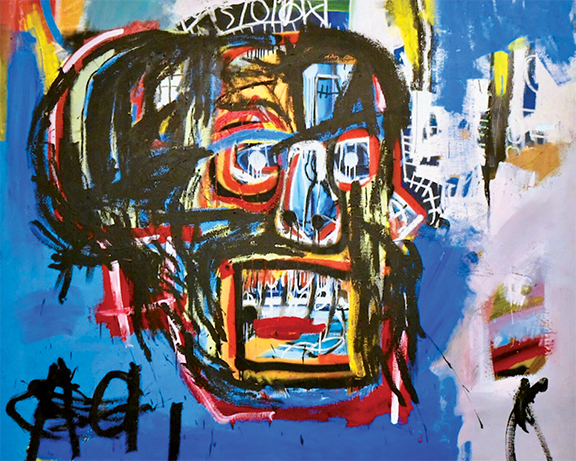
This untitled painting of artist Jean-Michel Basquiat sold for $110.5 million at auction. Photo courtesy Museum of Graffiti.
“It was time for a new generation to take over. The old guard and practices of art began to change,” insists RISK, who suggests progressive hoteliers are helping idiosyncratic artists to find an audience. “Hotel art was becoming stale, kind of like Muzak in elevators in the ’80s, and needed a new approach,” says the veteran artist. “Boutique hotels like The Mayfair are ahead of the curve and breathe fresh air into an exciting future for art, artists, and art enthusiasts,” says RISK.
Roger Gastman, an urban anthropologist and historian, is a leading authority on street art who counts The History of American Graffiti and Street World: Urban Art and Culture from Five Continents among his 50 books. Gastman remembers his own discovery of self-expression — through a spray paint can in the early 1990s — as a defining moment in his young life.
Gastman, whose first book, Free Agents: A History of Washington, D.C. Graffiti, documented the local culture he experienced in his youth, reports there is a distinction between graffiti and street art. “Graffiti is very name-based, very ego-driven, while street art is more image-based and involves additional tools and techniques,” says Gastman, but notes that both have their roots in vandalism. “Street art is a safer name and is more digestible to the public, but graffiti and street art are kissing cousins on the same playing field,” he muses.
“So much of this work is fantastic and deserves to be seen in a different light, collected and respected,” says Gastman, who laments, “A majority of galleries and museums still don’t accept this kind of art, look at it seriously or believe it should be shown.” Demographics, however, are driving attitudes, suggests Gastman. “People in their 30s and 40s grew up with graffiti, tattooing and skateboarding — it’s everywhere, in fashion, music and advertising — and it resonates with them.”
Last year, Gastman spearheaded the New York edition of Beyond the Streets, a massive 100,000-square-foot exhibition of prominent graffiti artists in Brooklyn, following a similar event in L.A. in 2018. “We basically built our own museum and 200,000 people walked through the doors,” he explains, adding, “It showcased graffiti and street artists, giving them respect and presenting their history in the proper light.”
Miami, whose Wynwood Arts District is defined by vibrant, multicultural murals, is a city with a strong tradition of street art, and its Museum of Graffiti pays homage to the approachable medium. Museum co-founder Allison Freidin explains, “Our goal is to celebrate a group of artists previously marginalized because of the stigma associated with graffiti,” and reports the Miami institution is the only one in the world exclusively dedicated to graffiti art. “Previously, there was no place to learn about these artists,” she adds.
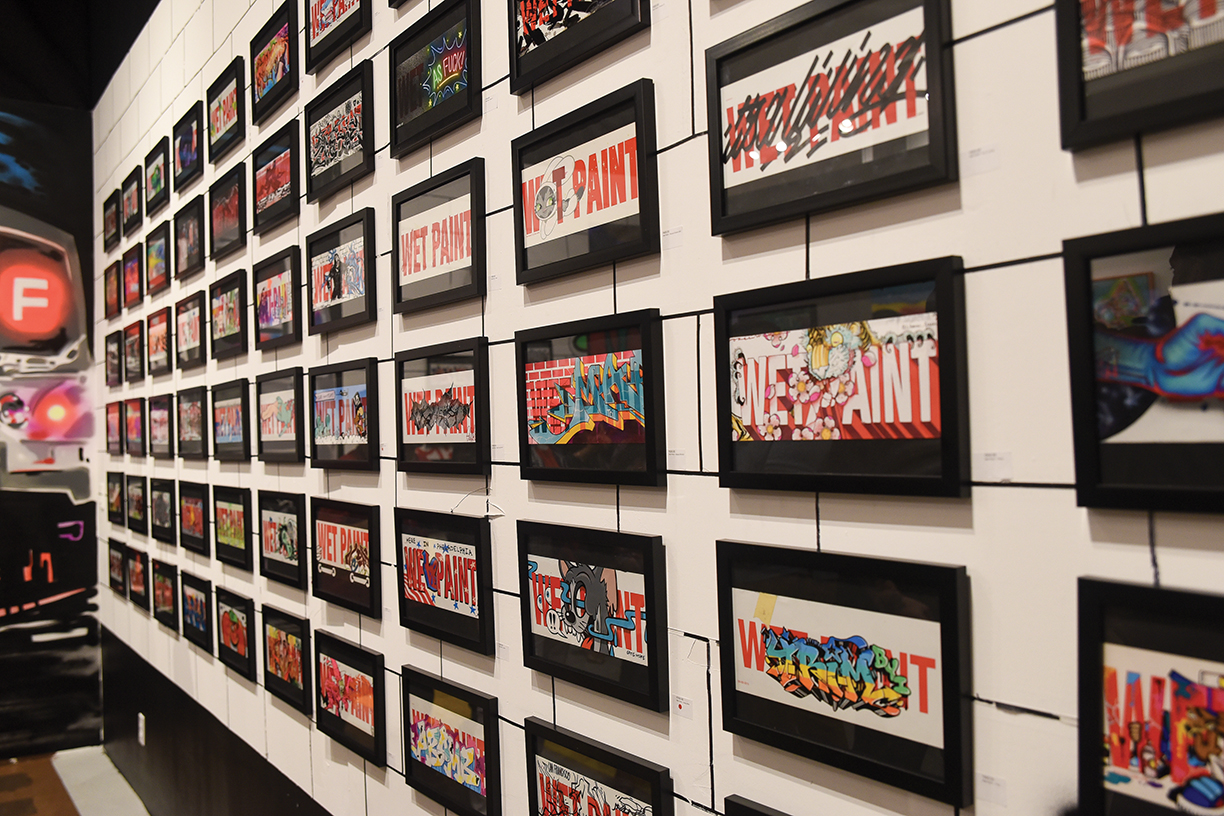
Above: The “Wet Paint” exhibit at the Museum of Graffiti in Miami, from artist Persue. Photo courtesy Museum of Graffiti.
At Right: “Party Felix” by Seen, one of many artists showcased at L.A.’s Mayfair Hotel. Photo courtesy the Mayfair Hotel.
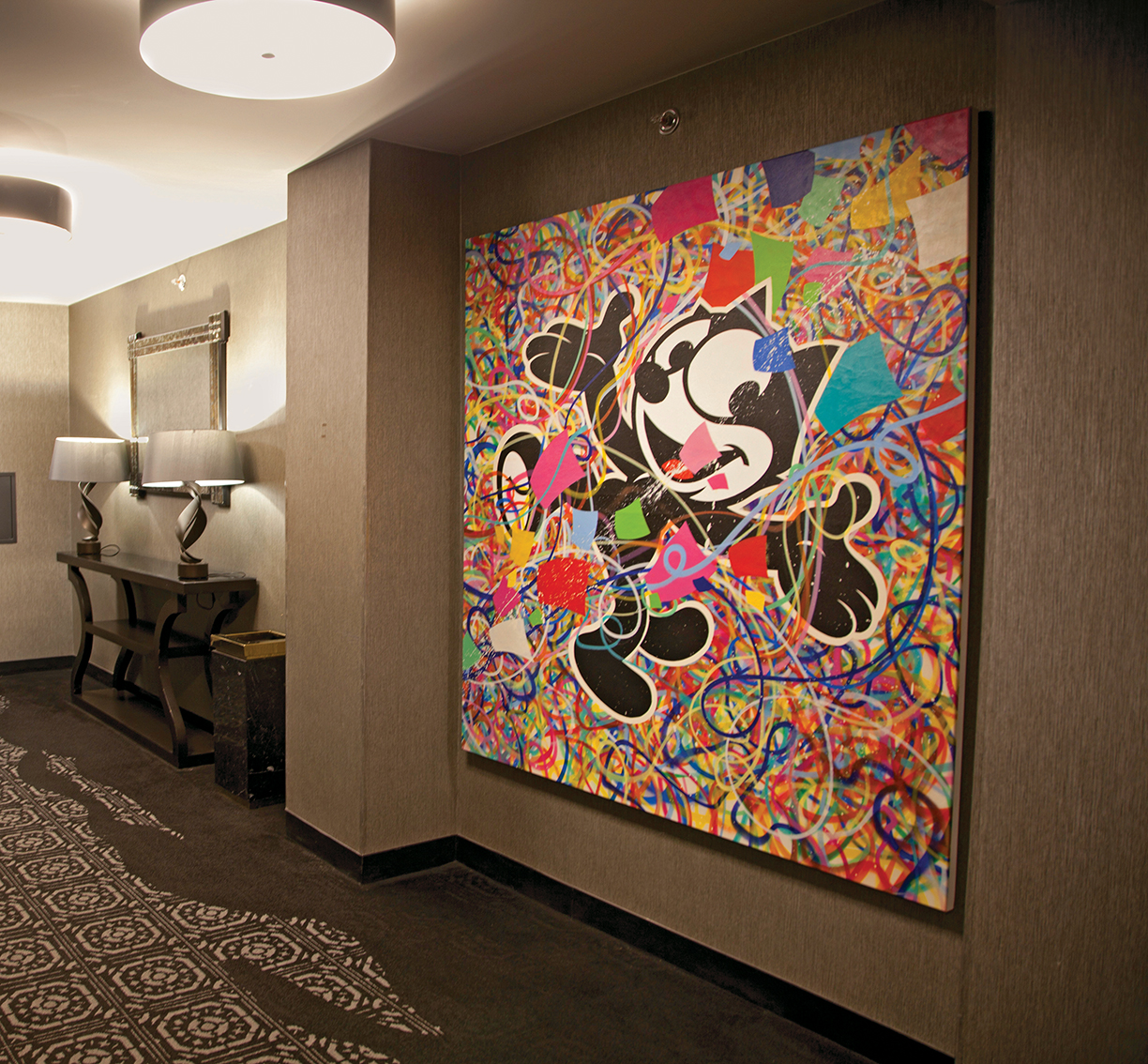
Explaining its location in a former shoe warehouse in Wynwood, Freidin reports, “The district’s relevance in the past 10 years is a product of the graffiti art that transformed a sleepy industrial neighborhood into the world-class arts destination it has become,” noting the windowless warehouses made ideal canvases for street artists. The Museum of Graffiti’s own building is entirely wrapped in 14 different murals by acclaimed local and international artists like Shoe, EZO and Abstrk.
The museum’s interior galleries feature rotating exhibits such as a recent compelling vignette from artist Persue, who famously removed the “Wet Paint” signs that New York City transit workers used to tape to subway cars after painting over graffiti art. Persue sent more than 70 of those very placards to artists around the world to use as canvases, all of which were incorporated into an exhibit whose physical design resembled a New York subway station platform.
Freidin explains that Miami’s graffiti art movement began in the early 1980s when some youth who got into trouble in New York were sent to South Florida to live with grandmothers or aunts. Insisting there is no way to repress the energies of an artist, Freidin reports, “The art erupted like a vengeance.”
The museum co-founder applauds the success of local graffiti artists like José Parlá, whose work moved from the streets of Miami to a mural inside Manhattan’s One World Trade Center, as well as multiple museum exhibitions and commissions in Tokyo, London and Havana. “He was immensely talented and continued to put in the work despite the stigma associated with graffiti art as vandalism,” says Freidin, who adds, “He’s probably one of the biggest names in contemporary art in the world.”
It was not easy for some museum curators to persuade their boards of directors that people previously labeled as vandals should be showcased in world-class fine arts facilities, but Freidin maintains society has evolved. She offers the former criminalization of marijuana as an analogy, citing its progression from disdain to broad acceptance. “It takes forward-thinking arts enthusiasts to take a risk,” and reports major corporations are hiring these artists as creative directors. “They recognize the power of this art,” says Freidin.
Robert Michael Provenzano, professionally known as CES, is a leading graffiti stylist whose signature aesthetic is now influencing the generation of artists currently emerging from the streets. His art, which began almost 40 years ago in his native Bronx, repeatedly got him into trouble as a young man, but after being flown to Munich to demonstrate his craft at a museum he realized there was a market for his skills. “My friends and I used to have to steal supplies, but now I’m a sponsored artist by a paint company in Barcelona,” says CES of how attitudes toward graffiti art have changed.
CES has since earned commissions from Nike and Palms Casino Resort in Las Vegas, in addition to collaborating on a mural adjacent to Miami’s Museum of Graffiti, where he was recently headlined. He finds it ironic that the artistic expression that was so strongly discouraged when he was a teenager is now a source of pride for his family. “I had no idea that if I stuck with it all those years, the whole world was gonna dig it,” reports CES.
The High Museum’s Michael Rooks notes, “The migration of some graf artists into the mainstream via museum collections and exhibitions underscores a familiarity with the language of the street that is widely recognized among urban audiences, as well as the influential role it has on global visual culture today.” He adds, “A fulcrum point in the migration from the street to the museum has to do with an artist’s knowledge and understanding of this legacy and ability to speak with urgency and artistry to contemporaneity.”
The ultimate measure of acceptance of art is the monetary value it commands in the marketplace. In 2017, an untitled work of Jean-Michel Basquiat, who began his career spray-painting walls in Lower Manhattan, sold for $110.5 million to a Japanese billionaire at auction, eclipsing his own personal record of $57.3 million.
Known for enchanting floral “graffiti,” Flower Designer Lewis Miller Is Sought-After for everything from weddings in Aspen to Parties in Venice.
By Samantha Myers
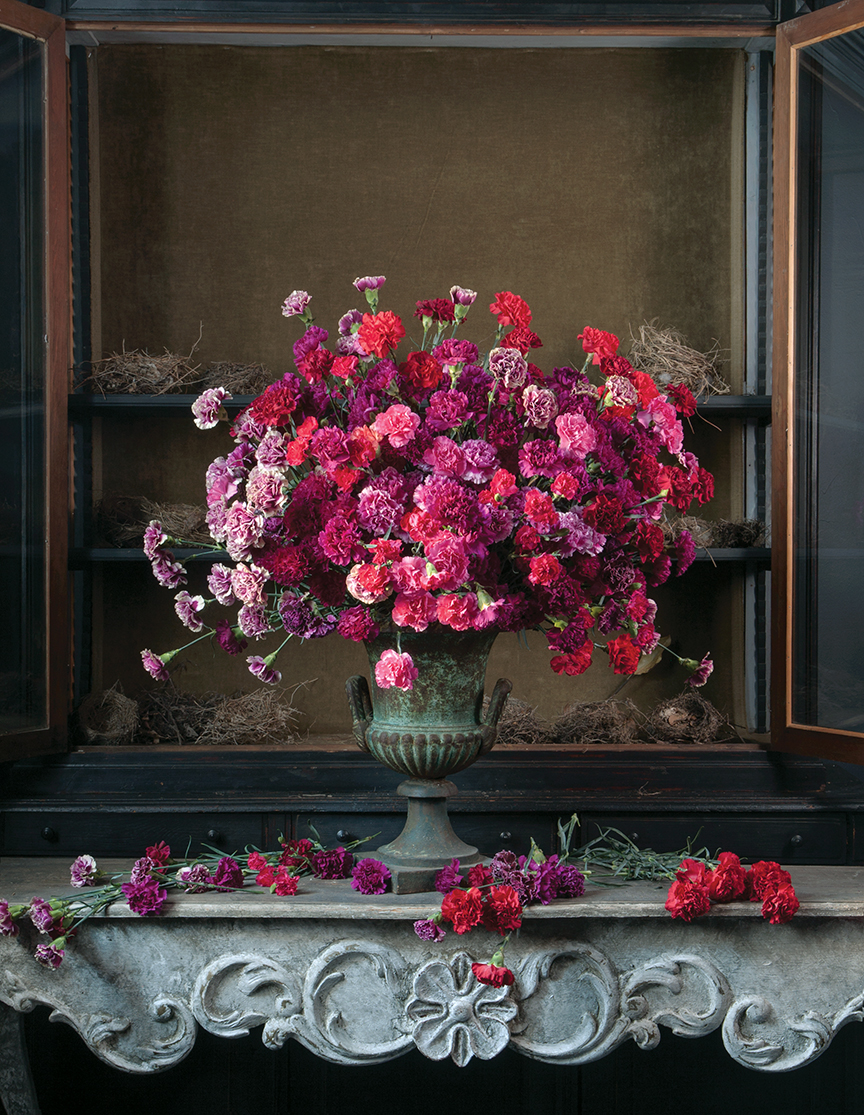
Photo ©Don Freeman Photography
Usually Lewis Miller’s beautiful flower arrangements can be found decorating exclusive events for his clients, which include the likes of Chanel, The Metropolitan Museum of Art and Vogue. But recently, Miller’s stunning designs have been popping up throughout the streets of New York City — beautifying city landmarks and otherwise unappealing trash cans in what he has coined “Flower Flashes.”
Despite his firm’s East Village location, Miller has not abandoned his country roots. “I’m living the closest thing to a country lifestyle in Manhattan,” Miller jokes of his situation — but it’s this specific city-meets-country aesthetic that has resonated with high-end clients enough to establish his firm as one of the premier floral powerhouses in the entire city.
Born and raised in California farm country, Miller developed an appreciation for nature at a young age and eventually moved to Seattle to study horticulture and landscape design. “I grew up as a farm kid and was always surrounded by flowers and growing things,” says Miller. “Then, it translated into floral design.” In 2000, Miller brought his discerning vision of country life to New York City, and worked for a successful floral boutique before launching his own company only two years later: LMD New York, Lewis Miller Design. “I have always loved growing flowers,” he says. “I love the immediacy of floral arrangements, and especially the effect they can have on a space.”
Beyond his roots, Miller’s inspiration comes from homes and gardens — “from the bucolic English garden, to the most formal,” he says. If versed in art history, one can also recognize the immediate influence of fine art on his designs. In fact, his book, Styling Nature: A Masterful Approach to Floral Arrangements (2016), which is filled with painterly photographs of his organic creations, discusses seventeenth-century Dutch still lifes as an influence.
“Art and painting are huge sources of inspiration for me,” he says. “The color, energy … sheer gut, visceral reaction it can give you. Whether it be a super modern, sloppy wet painting, or a really rich, sexy masculine Caravaggio, or a precious Flemish still life.”
The bulk of Miller’s work comes from creating arrangements for events — from travel and destination weddings in Aspen or the South of France, to cocktail parties for exhibition openings at The Met, to birthday parties in Venice. “We are primarily a social event business, but we do a select amount of corporate work,” explains Miller. He has decorated perfume shoots for the Italian luxury label Bulgari, and provided floral designs for an American Express Top 200 Member soiree. “My clients are not about the flash,” says Miller. “They want it to be gorgeous and inviting and warm, but they don’t want to look like they are spending the money. It needs to look completely organic.”
One of the more memorable celebrations Miller has worked on was a black-tie wedding at New York’s famous Katz’s Delicatessen, with a guest list donned in furs and tuxedos. “I had to do that one really quickly,” he recalls. “But I love doing things fast. So many things can take such a long time — you can excruciate over it for months, but it kills the energy.”
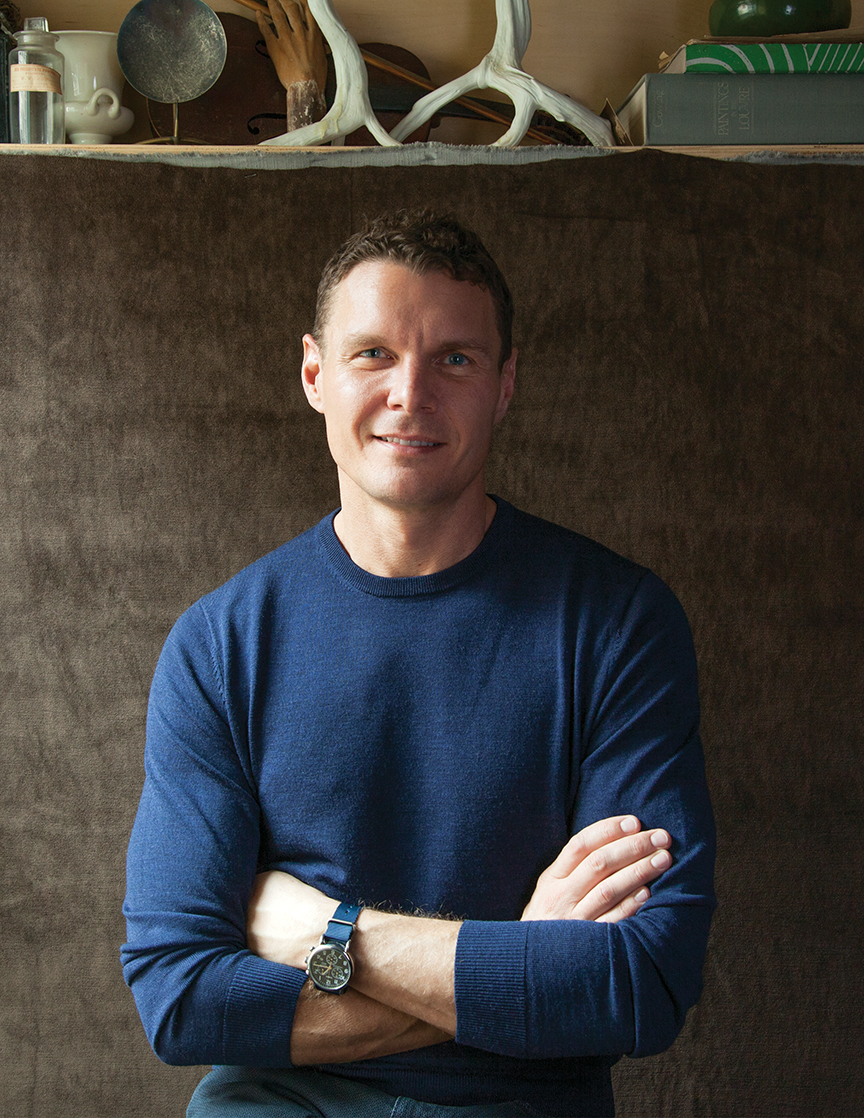
Flower Designer Lewis Miller
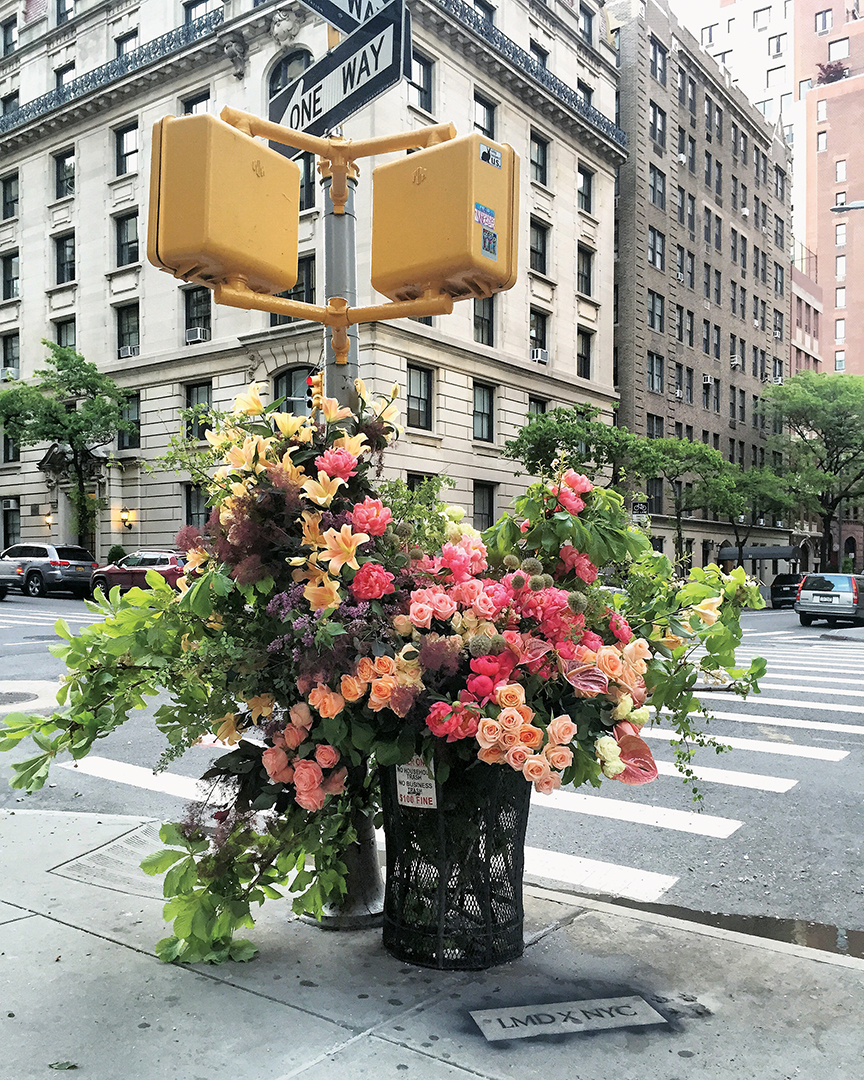
Photo ©Lewis Miller Design
To satisfy his love of immediacy, Miller has recently found an unexpected fusion of flower design and street art through his “Flower Flashes,” which has garnered immense, positive media attention. “I love art when it’s sort of one simple idea and it’s just done. And it’s there for whatever reason, and it’s not overly thought-out. As much as I love the country and fresh gardens, I love street art,” says Miller.
Using leftover flowers, Miller and his team complete these acts of floral graffiti at random spots throughout the city, thus earning him the nicknames “Banksy of Flowers” and the “Florist-Bandit,” among others. “It’s ethereal. It’s there and it’s gone. People take the flowers, and I like that. I want to see how it gets destroyed. People love flowers — you put a flower in front of them, and they are going to take it.”
“Doing something where no money is attached is really liberating,” Miller adds. “When you’re doing it as a gift and to brighten up someone’s day. Someone will walk around the corner and see the flowers and it’s so freeing. I had no idea it was going to blow up like it did.”
When it comes to describing his arrangements, Miller often uses the words “lush” and “sumptuous.” But when articulating overall style, he has crafted a definition with help from his clients. “You know, somebody once said that they were not only gorgeous, but also masculine gorgeous,” he says. “It feels rich, but completely unassuming. Thought-out, and abundant and inspired, but nobody feels like it was slaved over. Whether it’s a handle of weeds, or anything, I use it — it doesn’t have to be the most precious flower in the world.”
While Miller’s favorite kind of flower changes with the season, some of his choice ones include a Black and White French Anemone, fragrant garden roses and Black Hollyhock.
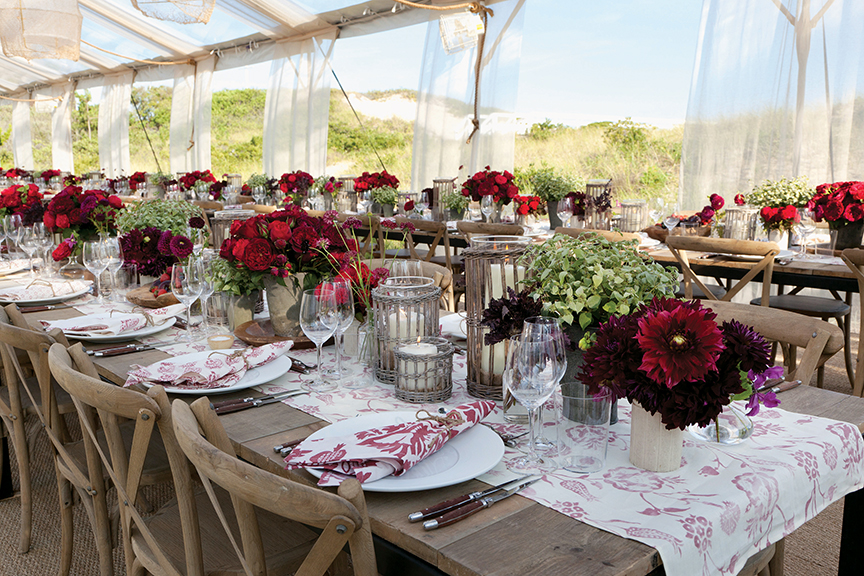
Photo ©Lewis Miller Design














